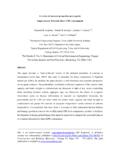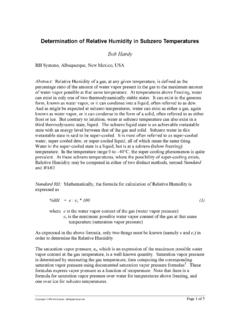Transcription of Understanding MSP430 Flash Data Retention - …
1 Application Report SLAA392 March 2008 1 Understanding MSP430 Flash data Retention Kripasagar Venkat, Uwe Haensel MSP430 Applications ABSTRACT The MSP430 family of microcontrollers, as part of its broad portfolio, offers both read-only memory (ROM)-based and Flash -based devices. Understanding the MSP430 Flash is extremely important for efficient, robust, and reliable system design. data Retention is one of the key aspects to Flash reliability. In this application report, data Retention for the MSP430 Flash is discussed in detail and the effect of temperature is given primary importance. The concepts discussed in this document are applicable to all MSP430 devices that are Flash based (F version), in any memory configuration. 1 Introduction Memory in general is broadly classified as read-only memory (ROM) or random-access memory (RAM). These two types behave differently, and each has its own set of merits and demerits.
2 Flash memory is a hybrid of ROM and RAM, inheriting the best features of both types of memories. Flash memory, driven by low cost, is electrically programmable, fast to read from, exhibits high density, and is nonvolatile. Flash memory is usually stacked as sectors and can be erased only as sectors. For the MSP430 devices, each sector of the main memory Flash is 512 bytes in length. Because the Flash memory is electrically programmable, it requires a sufficient voltage to erase and program efficiently. This voltage must be maintained during the entire Flash erase/write to ensure reliability of the operation. This topic is discussed in detail in the following section. The other limitation of Flash is the number of writes/erases, which has a direct impact on Flash wear out. Tips to ensure Flash longevity and factors that contribute to Flash failure are discussed in this application report. data Retention can be one of the primary concerns at extreme temperatures.
3 In this application report, emphasis is given to basics of Flash data Retention , factors that influence this parameter, and the various figures of merit to interpret Flash data Retention , along with tips to prevent failures on the MSP430 . SLAA392 2 Understanding MSP430 Flash data Retention 2 MSP430 Flash Characteristics The thick-oxide split-gate cell design used in the MSP430 has several advantages in terms of data Retention and endurance performance compared to other Flash cell architectures such as thin-oxide stacked-gate or thin-oxide two-transistor cell designs. It is easier to manufacture and less susceptible than thin-oxide designs to manufacturing defects that relate to data Retention loss over time. Flash Programming The erase state of every bit in any location in the MSP430 Flash is logic 1. It is important and recommended that the user perform an erase operation before writing/programming is done to any location in MSP430 Flash . Most of the MSP430 devices shipped from the factory have their main memory completely erased, while information memory might contain factory test data .
4 Programming Tips In this section, a few external and internal tips that should be followed to minimize adverse effects during system design are listed. Failure to adhere to any of these tips may result in unreliable Flash write/erase, leading to unpredictable Flash behavior. Internal Considerations Efficient programming of the MSP430 Flash is governed by two major requirements: supply voltage (DVCC) and the Flash timing generator clock (fFTG). For the MSP430F1xx and most of the MSP430F4xx family of devices, the supply voltage must be a minimum of V. The minimum supply voltage is reduced to V and V for the MSP430F2xx family and MSP430F5xx families, respectively. Particularly in battery-powered applications, battery capacity must be sufficient to meet the minimum operating voltage and currents necessary for in-application program/erase. The fFTG for MSP430F1xx, MSP430F2xx, and MSP430F4xx devices must be in the range of 257 kHz fFTG 476 kHz, while it is generated internally on the MSP430F5xx devices.
5 There is a practical limit on the number of Flash erase/write cycles for every MSP430 , which is in the range of 100,000 cycles. External Considerations Use of a programming adapter that has been certified to meet the MSP430 Flash programming specifications greatly reduces the risk of a Flash failure. Regular inspection for wear out of the programming socket also ensures better performance over time. If in-circuit programming is done via JTAG or boot loader, the programming operation should be performed at the end of the manufacturing cycle. Mechanical and thermal process steps, such as encapsulation mold cure, should be completed before programming. Verification is an important step that can be implemented, if Flash integrity must be checked. A checksum routine can be called on a regular basis for critical applications. In some of the MSP430F2xx, MSP430F4xx, and MSP430F5xx devices, the Marginal Read Mode is implemented to facilitate a checksum routine. Checksum routine values with and without this feature are compared to find weak programming Flash locations on the MSP430 .
6 Different values may indicate a violation of one or more of the above mentioned programming considerations. SLAA392 Understanding MSP430 Flash data Retention 3 Flash Failure Mechanism This section describes a few intrinsic and extrinsic failure mechanisms of Flash memory. Although these mechanisms are applicable to any industry Flash , they apply to the MSP430 Flash as well. Several tests are in place to ensure that each MSP430 that leaves the factory does not show any of the following symptoms. Charge Retention Charge Retention is the ability of the Flash cell to retain its programmed value during long-term storage. If there are defects in the dielectrics or the substrate, charges can move to or from the floating gate, causing elevated charge loss. Also, with sufficient thermal activation, all bits could lose their charge. Analyses indicate that this failure mechanism occurs well beyond the normal lifetime of the device. Charge Retention is discussed more in Section Oxide Degradation The high fields used during program and erase can result in increased low field leakage through the dielectrics of the cell.
7 This can increase the susceptibility to charge loss of the cell. Analyses and long-term storage results have verified that the post-cycling Retention performance of the cells extends well beyond normal lifetimes. Program/Erase Time Degradation After a large number of write/erase cycles, a high charge can be trapped in the dielectrics surrounding the floating gate. This charge can decrease the effective field across the cell during program and erase operations, increasing the time required to complete the program/erase operations. data on TI Flash cells has shown that the erase/program time walk-out is well beyond normal use conditions. Write Disturb During the program operation, high fields are placed not only on the bit being programmed, but on other bits along the same word line and/or bit line. If there are defects in the dielectrics or in the substrate, leakage paths can be created, so inadvertent programming of a non-selected bit can be observed. To address this defect mechanism, high-voltage screens are in place in the test program to eliminate such units from the population.
8 These are some of the failure mechanisms that could occur to any Flash , and tests are place to for screen out any MSP430 devices that might have them. Flash data Retention data Retention of any Flash is the ability to retain its programmed state. Flash data Retention is known to degrade over temperature. Various tests and methods are in place to determine the reliability of Flash . Tthis application report mainly addresses the concept of accelerated test and the use of statistics to predict reliability. SLAA392 4 Understanding MSP430 Flash data Retention Accelerated Tests To test the Flash data Retention at various temperatures we make use of accelerated tests on the Flash . These tests are wholly based on Arrhenius law and equation. The Arrhenius theory allows the test of any device under accelerated environments for short periods and predicts the behavior under normal conditions for longer periods. Similar tests are performed on the MSP430 Flash to test and predict data Retention .
9 During each test, an unprogrammed device is subjected to these tests. A Flash failure is indicated when any of the Flash cells change from an unprogrammed state (logic 1) to logic 0. The Arrhenius equation is shown in Equation 1. =12aT1T1kEeAF (1) AF = Acceleration factor Ea = Activation energy ( eV for data Retention ) k = Boltzmann's constant ( x 10-5 eV/K) T1 = Application junction temperature in Kelvin T2 = Accelerated stress junction temperature in Kelvin Depending on AF, a back calculation using the Arrhenius equation for any desired temperature leads to fairly accurate data - Retention times. Infant Mortality Test During Production This test is not a Flash data Retention test, rather, it is performed to screen out infant mortality among devices during production. It is an accepted theory that all devices statistically follow a bathtub curve when it comes to failures. The infant mortality failures would fall into the left hand slope of the bath tub curve.
10 Under this test, all of the MSP430 devices are baked for 72 hours or 144 hours at 250 C. Flash data Retention Tests During Qualification To determine the Flash data Retention , further tests are conducted during qualification of the MSP430 devices. Two cases are explained in this section for different temperature and baking time. Case 1: 420-Hour Baking Time at 170 C In this test, the MSP430 is continuously subjected to this high temperature of 170 C for 420 hours. The purpose of this test is to determine data Retention at higher temperatures, and then calculate expected data Retention at 25 C using Equation 2. Using T1 = 25 C and T2 = 170 C in Equation 1 gives the following AF: 2085eeAF(298)1(443) )(25C1273)(170C1kE5a=== + + (2) SLAA392 Understanding MSP430 Flash data Retention 5 Using this AF information, back substitution gives the data Retention in years at 25 C.

















